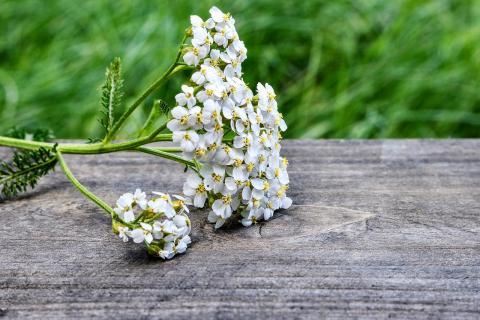
Recently, a client was hauling it very quickly down a hill on his road bicycle and took a trip over the handlebars. Unfortunately, spandex doesn’t do much to protect the skin and he wound up with some pretty nasty road rashes, something most cyclists are familiar with (or may be at some point if not yet).
The issues with road rash, aside from the pain, are the potential for infection and scarring. The top protective layer of skin is gone; there is often road debris in the wound and it just plain hurts! The following recipe was a great addition to my client’s first aid routine. The abrasions did not become infected and the rashes healed quickly. Aside from that, the blend costs little to make. You can make a large batch and freeze it as ice cubes for long-term storage, since it does take a bit of time to put together.
Road Rash Ointment Ingredients (& why they’re included)
• 1/2 cup dried comfrey leaf
• 1/2 cup dried rose petals
• 1/2 cup dried lavender
• 1/2 cup dried yarrow
• 64 oz pure aloe vera (make sure it doesn’t have any irritating additives or preservatives like alcohol, citric acid, etc.)
Comfrey leaf is a wonderful tissue-regenerating herb for speeding the healing and reducing the pain of abrasions. It’s perhaps better known as Knit-bone, and has traditionally been used to support the healing of broken bones and damaged connective tissue. Don’t use it on puncture wounds or other deep wounds, where comfrey may heal the surface layer so quickly that the deeper tissues don’t have time to heal and may abscess. Comfrey provides allantoin, an organic chemical that stimulates regeneration of skin cell layers, and additional plant components that reduce inflammation.
Rose petals contain astringent tannins that help protect the wound and staunch the oozing of serum as the wound heals. Rose petals also provide cooling, soothing anti-inflammatory support for reducing swelling and pain and anti-bacterial volatile oils for protecting the abrasion from infection. Plus, they smell good…a little first aid aromatherapy!
Lavender flowers and upper leaves are strongly anti-septic, relieve pain, and speed the healing process by stimulating tissue regeneration. Lavender reduces scarring and, like rose, lends a little scented support if you’ve got the road rash blues. I once cut my arm deeply with glass while in the middle of moving. A yarrow (next on the list!) poultice stopped the bleeding and prevented infection for the first couple of days. Then I switched to lavender essential oil — specifically, Lavandula angustifolia — diluted in olive oil to apply along the edges of the wound. Despite the depth and width of the gash, infection was not a problem and the remaining scar is a tiny fraction of the initial size of the wound. Lavender tea as a wash or compress, or lavender-infused olive oil would have also worked well.
Yarrow is yet another great wound-healing plant; hence, it’s other name “Woundwort.” In fact, its botanical name, Achillea, is named for Achilles the Greek warrior who used yarrow to staunch wounds on the battle field. Yarrow quickly stops bleeding while being strongly antibacterial and reducing inflammation. Yarrow, like comfrey and lavender, is also a “vulnerary,” accelerating tissue regrowth.
Last but not least is Aloe vera. Though you could simply use water to make the road rash remedy, why not use the juice of this amazing healing plant instead? This and other Aloe species stimulate immune system function for fighting infection while reducing inflammation and pain. I have a couple aloe plants in my kitchen window to grab for my frequent burns while cooking…it is one of the best remedies for a variety of surface wounds.
Instructions for Making a Road Rash Blend
I like to soak the herbs for about 20-30 minutes in just enough alcohol to wet them through and to inactivate any bacteria or mold. (Just being careful here.) For this, 70% ethanol is good. You can get pretty close by mixing about 3 parts absolute alcohol to 1 part water. I use the organic alcohol that I have on hand for tincture making, but even Everclear works. Then, add the herbs to the aloe juice in a double boiler and heat on low for 30 minutes, with lid cracked. Don’t let the water in the double boiler actually come to a boil. Stir periodically. Remove from heat and steep another few hours with a lid on. Strain, pour into clean ice cube trays, and freeze. Once frozen, you can store your herbal cubes in a lidded container in the freezer. They can be thawed as needed and used as a spray or wash, or for a compress a couple or few times a day.
All of these plants would be great additions to your healing garden and can even be grown on a balcony in pots. It’s good to harvest them throughout the season to dry down and store so that you have them whenever needed!








